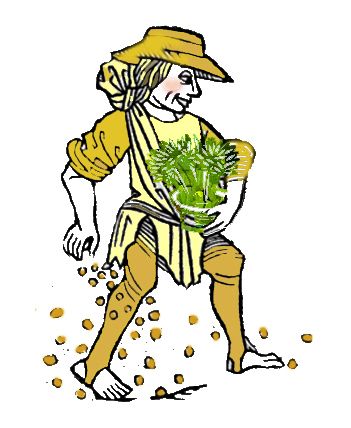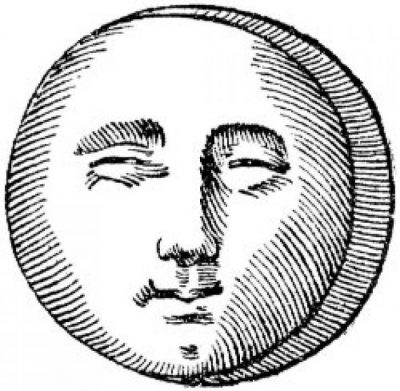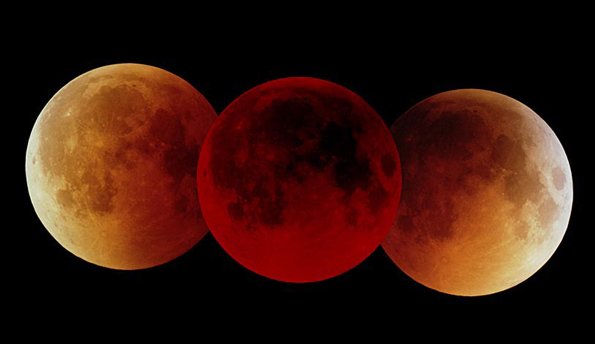- Note that the garden activities associated with the Moon Sign depend also on the cycle the Moon is in. The Moon transiting through a fertile or productive Sign will no be so favorable if the Phase is not a productive one, and vice-versa. For best results the Sign and Phase of the Moon have to be considered together.
 The New Moon
The New Moon
The New Moon is the beginning of the Waxing cycle, the sacred marriage of Moon and Sun, Yin and Yang, Night and Day. For three days the Moon becomes invisible. Astrologically we say that the Moon is now conjunct the Sun (on the same degree of Longitude along the Ecliptic). Every month the New Moon occurs in a different Sign. So the Aries New Moon in March/April is always followed by the Taurus New Moon in April/May and so on. New Moons are symbols of new beginning and represent a great time to start something or make important changes in our lives. The energy is right for everything new you would like to try.
***
![]()
The New Moon Phase in the garden
The New Moon Phase is traditionally a time to begin sowing and planting because the increasing Moon light will help plants to emerge and flourish. Moisture becomes more and more available as the light of the Moon intensifies, up to the Full Moon. Traditionally however no sowing or planting are recommended within twelve hours of the phase itself.
Everything can go in now, but in particular leafy vegetables and all plants that we grow for their above the ground parts, but only when the Moon is transiting through the very fertile Water Signs or the productive Signs Taurus, Libra and Capricorn.
 Crescent Moon
Crescent Moon
The Crescent Moon occurs half way through the first week of the Waxing cycle, when the Moon is transiting 45 degrees ahead of the Sun and looks like a beautiful crescent in the western sky after sunset. Psychologically this is an enthusiastic time, in which lots of ideas crowd our mind and we may feel that the sky is the limit. It is a slightly naïve Moon time, but also one full of hopes and dreams (the bright crescent shows now the shadowy sphere of the future Full Moon. The energy of the Moon however needs maturing at this stage and grounding. The first difficulties may appear, the first chinks in the armor; but the challenge is not strong enough yet for us to build up on it.
![]()
The Crescent Moon Phase in the garden
The Crescent Moon Phase is an excellent time for sowing and planting because moon light is rapidly increasing now and therefore also plants’ ability to draw water from deep in the soil.
Everything can go in now, but in particular leafy vegetables and all plants that we grow for their above the ground parts, but only when the Moon is transiting through the very fertile Water Signs or the productive Signs Taurus, Libra and Capricorn.
 First Quarter
First Quarter
The Moon is now 90 degrees ahead of the Sun, a right angle, very powerful. We meet some serious obstacle on our way. The goal is still strongly in view (Full Moon) but something or someone seem intent at stopping us or hinder our progress. This is the most critical point in the waxing period. It is important that we meet the challenge now, but it is also essential that we don’t go to war with people around us, blaming them for our difficulties, which are instead just a natural phase of our journey. There is something a bit black and white in this Moon’s position and the attention is perhaps focused too much on outside circumstances.
![]()
First Quarter Moon Phase in the garden
The First Quarter Moon Phase is the demarcation time between the first and second weeks of the Moon cycle, an important boundary, because different types of plants can now go in, those we grow for their fruit or seedpods (tomatoes, beans etc.). The Moon needs also to be transiting a Fertile or Productive Sign.
***
 Gibbous Moon
Gibbous Moon
The Moon is waxing, 135 degrees ahead of the Sun, only 45 degrees or three and half days to the Full Moon. The Moon shows a strange shape now, like a rugby ball. Our goals are becoming more clear and we can power ahead, not too concerned about possible obstacles on our path. The power of attraction of the Full Moon proves irresistible.
![]()
The Gibbous Moon Phase in the garden
The Gibbous Moon Phase should stimulate plenty of garden activities and a sense of urgency, least one should waste the great energy available. When the Moon transits a very fertile Sign like Cancer, Scorpio, Pisces, or a productive Sign like Taurus, Libra and Capricorn, plus Virgo for Medicinal Herbs, practically every plant and seed can go into the garden successfully. This is the middle of the second waxing week. Ideally, after sowing or planting leafy vegetables in the first week, we should be busy putting in those plants we grow for their fruit or seedpods (tomatoes, beans, etc.).
***
 Full Moon
Full Moon
At Full Moon the Moon has reached a distance of 180 degrees ahead of the Sun, becoming diametrically opposed to it, with planet Earth in the middle. This is symbolically harvest time, when we reap what we have sown in the waxing period. We might experience success or failure, but either way we are coming to some important realization. The cycle has now reached its half way mark and is at its most intense. Like the New Moon a fortnight earlier this is also a time for new beginnings, not in the naïve, tentative way of the New Moon, but in a more mature and conscious way.
![]()
The Full Moon Phase in the garden
In the garden the Full Moon is a great divide: before the exact phase the increasing light and surging energy are particularly good for Annuals and above the ground crops; after the phase Perennials, Biennials, Trees and Root crops are more suited. Traditionally no sowing or planting are recommended however twelve hours before or after the phase itself. In this instance the best day would be then May 8, from 8.45 am until 5.15 pm, when the Moon enters Sagittarius.  Disseminating Moon
Disseminating Moon
The Moon is now on her return journey. This phase occurs three and half days past the Full Moon. It has been given this name because this is a time for spreading and sharing the knowledge or realization we have gathered at the Full Moon. It is the first step on the inner journey which began at the Full Moon, but it can still be an active time in the world too, with the need to reach out to others. The Moon has past her prime, but her still strong light is a reminder of her recent fullness.
![]()
The Disseminating Moon Phase in the garden
In the garden, despite the rapidly diminishing Moon light, the Disseminating Phase is a productive time for growing things and also to apply slow release fertilizer. The fact that these are the last available days for planting before the Last Quarter should work as an incentive to get going. Favorite plants to grow during this first week of the waning cycle are the Perennials, Biennials and Root Crops because the Moon energy is being stored underground in anticipation of the resting period not too far ahead.
Last Quarter
If the First Quarter presented us with external challenges to overcome in order to achieve the goal promised by the Full Moon, at the Last Quarter we feel that whatever bar our progress is within us and not without. We can now take responsibility for our life and circumstances. The battle needs to be fought with oneself and not other people. Both Quarters are crucial times that suggest division and strife, but while at the First Quarter we could find refuge in the illusion that the cause of all the problems was someone or something else, now we can clearly see how we contribute to whatever crisis we may be experiencing. The Moon is now 90 degrees behind the Sun, another right angle. The friction generated by the inner dialogue could be very creative if you don’t let it depress you.
![]()
Last Quarter Moon Phase in the garden
The Last Quarter Moon is the beginning of the fourth and last waning week, before New Moon. We should stop all sowing and planting, and concentrate on soil conditioning, cultivation, slow release fertilizing and composting. This phase is suitable also for harvesting and storing fruit and vegetables; as well as getting rid of unwanted weeds and pests, particularly if the Moon transits any of the Fire Signs, or Non Fertile Earthy Virgo, or the Non Fertile Air Signs of Gemini and Aquarius.
*******
Balsamic Moon
The Moon is 45 degrees behind the Sun, only three and half days to New Moon. The Moon light is decreasing rapidly and the lunar energy is now being stored as nutrients in the seeds of future plants. It is also the calm before the storm of activities of the New Moon. Time for contemplation, self reflection and healing. The title Balsamic Moon is derived from the word ‘balsam’, unguent which helps to relieve pain and cure ills. During this time we could distil the essence of our past experience, from the last New Moon up to this point, reflect upon what we have experienced and learnt, getting psychologically ready for the cycle which is about to open. This is a spiritual phase, more suitable for meditation and relaxation than action.
![]()
Balsamic Moon Phase in the garden
-
Note that the garden activities associated with the Moon Sign depend also on the cycle the Moon is in. The Moon transiting through a fertile or productive Sign will no be so favorable if the Phase is not a productive one, and vice-versa. For best results the Sign and Phase of the Moon have to be considered together.
The Balsamic Moon is certainly no time for planting or sowing, but it is ideal instead for cultivation and soil conditioning, slow release fertilizing, composting, mulching.
It is great week for eradicating pests and unwanted plants and also to prune in order to retard growth, but only if the Moon is transiting a Non Fertile Sign.
copyright 2003/2020 livingmoonastrology.com ©












































March 31, 2010 at 11:18 pm
I just discovered your site…and what a JOY! I love everything about it and my insight and knowledge is increasing with each page 🙂
What a treasure you are. Thank you very much for sharing this, I greatly appreciate it.
Enjoy your Spring my friend *X*
September 16, 2011 at 3:15 am
This is the best discussion of the Moon phases I’ve found. Great stuff, keep up the good work.
William G. Foster
aka: The Master of Disaster
http://wfoster2011.wordpress.com/
April 23, 2013 at 8:40 pm
A great reference and insight that helps on a personal and world level, I’m a fan of your work.